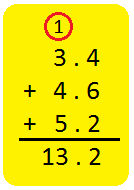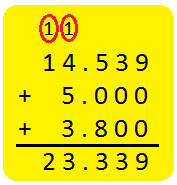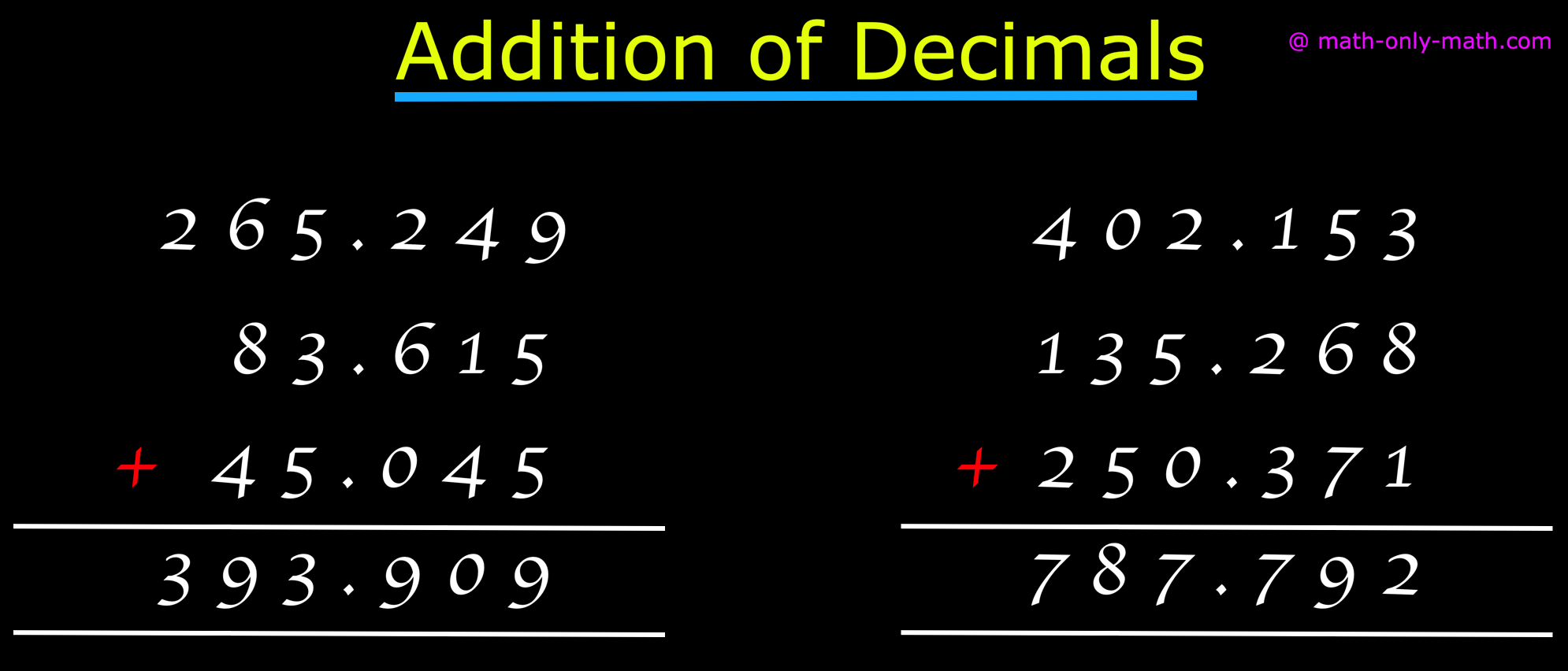Subscribe to our ▶️ YouTube channel 🔴 for the latest videos, updates, and tips.
Addition of Decimals
We will discuss here about the addition of decimals. Decimals are added in the same way as we add ordinary numbers. We arrange the digits in columns and then add as required.
How to add decimals?
We add the decimals as we add the whole numbers. Before adding decimals, we arrange the digits in column as per their place value. If there is no digit for any place. It can be taken as zero (0).
Let us consider some of the following examples on adding decimals.
1. Add 3.4, 4.6 and 5.2
|
Step I: Write the numbers vertically aligning on the decimal points. Add the tenths. 4 + 6 + 2 = 12 Place 2 in the tenths column and place the point before it. Carry 1 to the whole number part. Add the whole numbers. 3 + 4 + 5 + 1 = 13 The sum of 3.4, 4.6 and 5.2 is 13.2 |
The required sum is 13.2 |
2. Add 14.539, 5 and 3.8
|
Step I: Write the numbers vertically aligning on the decimal points. Write equivalent decimals of 5 and 3.8 up to three places. 5 = 5.000 3.8 = 3.800 Add thousandths 9 + 0 + 0 = 9. Write 9 under thousandths Add hundredths 3 + 0 + 0 = 3. Write 3 under hundredths Add tenths 5 + 0 + 8 = 13. Write 3 under tenths and carry 1 to ones place. Add ones. 4 + 5 + 3 + 1 = 13. Write 3 under ones and carry 1 to tens place. Add tens. 1 + 1 = 2. Write 2 under tens. |
The required sum is 23.339 |
3. Add 46.25, 108.45 and 456.62
We arrange the digits of decimals in columns and then we add the numbers as usual.
|
4 6 . 2 5 1 0 8 . 4 5 + 4 5 6 . 6 2
6 1 1 . 3 2 |
While adding we ensure that the decimal point of all the numbers should be in the same column. |
Sometimes the numbers to be added may not have digits for each column. In such case, we can add zero at the extreme right or left of a given decimal number.
4. Add 230.45, 189.568 and 25.709
Here we will see adding decimals in two ways. We arrange the digits of decimals in columns and then we add the numbers as usual.
|
2 3 0 . 4 5 1 8 9 . 5 6 8
+ 2 5 . 7 0 9 4 4 5 . 7 2 7 |
Or, |
2 3 0 . 4 5 0 1 8 9 . 5 6 8 + 0 2 5 . 7 0 9
4 4 5 . 7 2 7 |
5. Add the following decimals:
(i) Add 13.8 and 4.32
(ii) Add 4.6 and 15.23
Solution:
(i) Add 13.8 and 4.32.
13 . 8
+ 4 . 32
_______
or
13 . 80
+ 04 . 32
18 . 12
(ii) Add 4.6 and 15.23.
4 . 6
+ 15 . 2
_______
or
04 . 60
+ 15 . 23
19 . 83
Worksheet on Addition of Decimals:
Questions and Answers on Addition of Decimals:
I. Add the following decimals:
(i) 7.9 + 2.8 + 3.2 + 16.8 = ..............
(ii) 83.1 + 18.2 + 45.4 + 14.7 = ..............
(iii) 24.35 + 19.10 + 28.39 + 5.40 = ..............
(iv) 10.00 + 1.05 + 2.30 + 8.75 = ..............
Answer:
I. (i) 30.70
(ii) 161.40
(iii) 77.24
(iv) 22.10
II. Find the sum of the following decimals: (Addition of 3 decimals)
|
(i) |
3 5 . 2 5 1 5 . 2 0 + 4 4 . 9 7_ __________ |
(ii) |
2 5 3 . 5 3 0 2 9 . 0 2 1 + 3 . 0 9 0_ ____________ |
|
(iii) |
9 8 . 2 4 9 1 0 7 . 2 5 1 + 2 7 0 . 4 3 1_ ______________ |
(iv) |
3 6 . 0 0 0 4 . 0 9 0 + 3 1 5 . 2 0 5_ ______________ |
|
(v) |
9 5 . 0 9 2 9 7 . 5 0 5 + 9 2 . 3 0 9_ _____________ |
(vi) |
2 6 5 . 4 2 9 8 3 . 6 1 5 + 4 5 . 0 4 5_ _____________ |
Answer:
I. (i) 95.42
(ii) 285.641
(iii) 475.931
(iv) 355.295
(v) 284.906
(vi) 393.909
From Addition of Decimals to HOME PAGE
Didn't find what you were looking for? Or want to know more information about Math Only Math. Use this Google Search to find what you need.





New! Comments
Have your say about what you just read! Leave me a comment in the box below. Ask a Question or Answer a Question.